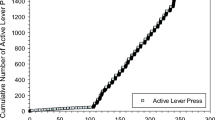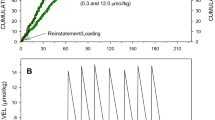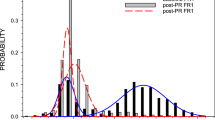Abstract
Four male rats performed during 35-min sessions under a schedule that arranged water delivery (0.04 ml) after every fortieth response. Cocaine (1.0–16.0 mg per rat, i.p.) was administered 15 min, 30 min, 60 min or 120 min prior to a session. When given 15 min prior to a session, cocaine (1.0–8.0 mg) in all rats produced dose-related decreases in responding. The largest dose, when given 15 min pre-session to two rats, almost completely suppressed responding. Lengthening the time between drug injection and test session attenuated the rate-decreasing effects of cocaine (1.0–8.0 mg), but did not affect the almost complete suppression of performance seen with the largest dose. Small doses (1.0–4.0 mg) had no effect on the pause in responding that occurred after water delivery. The 8.0-mg dose lengthened the pause by approximately 9000% and 650% when given 15 and 30 min prior to a session, respectively, but by less than 50% when given 60 or 120 min pre-session. Cocaine effects depend on the dose as well as the time of its administration prior to testing.
Similar content being viewed by others
References
Costa, E., Groppetti, A., Naimzada, M. K.: Effects of amphetamine on the turnover rate of brain catecholamines and motor activity. Brit. J. Pharmacol. 44, 742–751 (1972)
Crow, T. J.: Enhancement by cocaine of intra-cranial self-stimulation in the rat. Life Sci. 9, 375–381 (1970)
Fog, R.: Stereotyped and non-stereotyped behaviour in rats induced by various stimulant drags. Psychopharmacologia (Berl.) 14, 299–304 (1969)
Goldstein, A., Aronow, L., Kalman, S. M.: Principles of drug action: The basis of pharmacology. 2nd ed. New York: Wiley 1974
Heise, G. A., Boff, E.: Continuous avoidance as a base-line for measuring behavioral effects of drugs. Psychopharmacologia (Berl.) 3, 264–282 (1962)
Maickel, R. P., Cox, R. H., Jr., Miller, F. P., Segal, D. S., Russell, R. W.: Correlation of brain levels of drugs with behavioral effects. J. Pharmacol. exp. Ther. 165, 216–224 (1969)
Nayak, P. K., Misra, A. L., Mulé, S. J.: Physiological disposition and biotransformation of [3H]-cocaine in acute and chronically-treated rats. Fed. Proc. 34, 781 (1975)
Pickens, R., Thompson, T.: Cocaine-reinforced behavior in rats: Effects of reinforcement magnitude and fixed-ratio size. J. Pharmacol. exp. Ther. 161, 122–129 (1968)
Randrup, A., Munkvad, I.: Biochemical, anatomical and psychological investigations of stereotyped behavior induced by amphetamines. In: Amphetamines and related compounds. E. Costa and S. Garattini, eds. New York: Raven Press 1970
Scheel-Krüger, J.: Behavioral and biochemical comparison of amphetamine derivatives, cocaine, benztropine and tricyclic anti-depressant drugs. Europ. J. Pharmacol. 18, 63–73 (1972)
Schoenfeld, R. I., Seiden, L. S.: Effect of α-methyltyrosine on operant behavior and brain catecholamine levels. J. Pharmacol. exp. Ther. 167, 319–327 (1969)
Schuster, C. R., Thompson, T.: Self administration of and behavioral dependence on drugs. Ann. Rev. Pharmacol. 9, 483–502 (1969)
Sidman, M.: Tactics of scientific research. New York: Basic Books, Inc. 1960
Sidman, M., Stebbins, W. C.: Satiation effects under fixed-ratio schedules of reinforcement. J. Comp. physiol. Psychol. 47, 114–116 (1954)
Smith, C. B.: Enhancement by reserpine and α-methyl dopa of the effects of d-amphetamine upon the locomotor activity of mice. J. Pharmacol. exp. Ther. 142, 343–350 (1963)
Smith, C. B.: Effects of d-amphetamine upon operant behavior of pigeons: Enhancement by reserpine. J. Pharmacol. exp. Ther. 146, 167–174 (1964)
Smith, C. B.: Effects of d-amphetamine upon brain amine content and locomotor activity of mice. J. Pharmacol. exp. Ther. 147, 96–102 (1965)
van Rossum, J. M., Simons, F.: Locomotor activity and anorexigenic action. Psychopharmacologia (Berl.) 14, 248–254 (1969)
van Rossum, J. M.: Mode of action of psychomotor stimulant drugs. Int. Rev. Neurobiol. 12, 307–383 (1970)
Villarreal, J. E., Guzman, M., Smith, C. B.: A comparison of the effects of d-amphetamine and morphine upon the locomotor activity of mice treated with drugs which alter brain catecholamine content. J. Pharmacol. exp. Ther. 187, 1–7 (1973)
Wallach, M. B., Gershon, S.: A neuropsychopharmacological comparison of d-amphetamine, l-dopa and cocaine. Neuropharmacology 10, 743–752 (1971)
Author information
Authors and Affiliations
Additional information
This research was supported by USPHS Grants MH-11, 191 and RO1-MH-22,971.
Supported by USPHS Training Grant MH-07083.
Supported by Research Scientist Development Award, 5-KO2-MH 10,562.
Rights and permissions
About this article
Cite this article
Macphail, R.C., Seiden, L.S. Time course for the effects of cocaine on fixed-ratio water-reinforced responding in rats. Psychopharmacologia 44, 1–4 (1975). https://doi.org/10.1007/BF00421174
Received:
Revised:
Issue Date:
DOI: https://doi.org/10.1007/BF00421174




